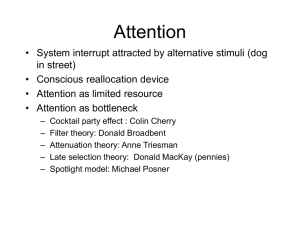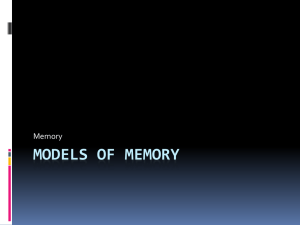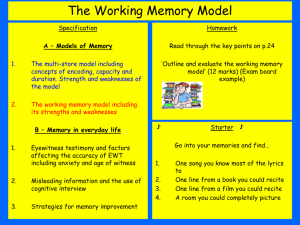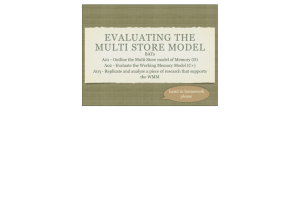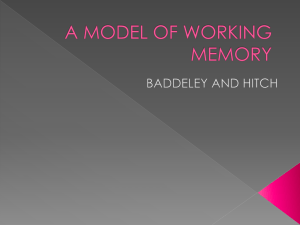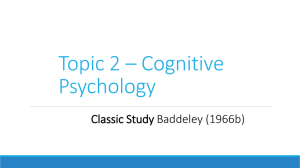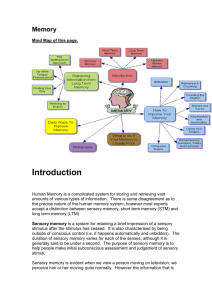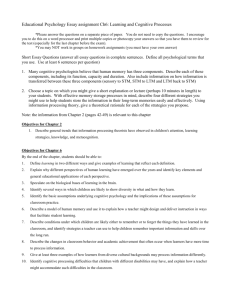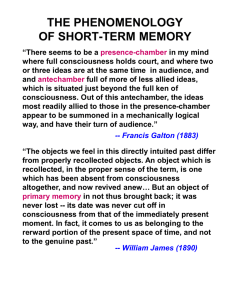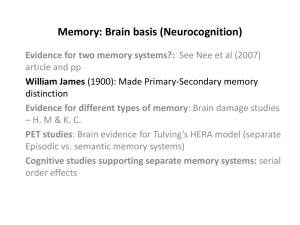memory - itslearning
advertisement
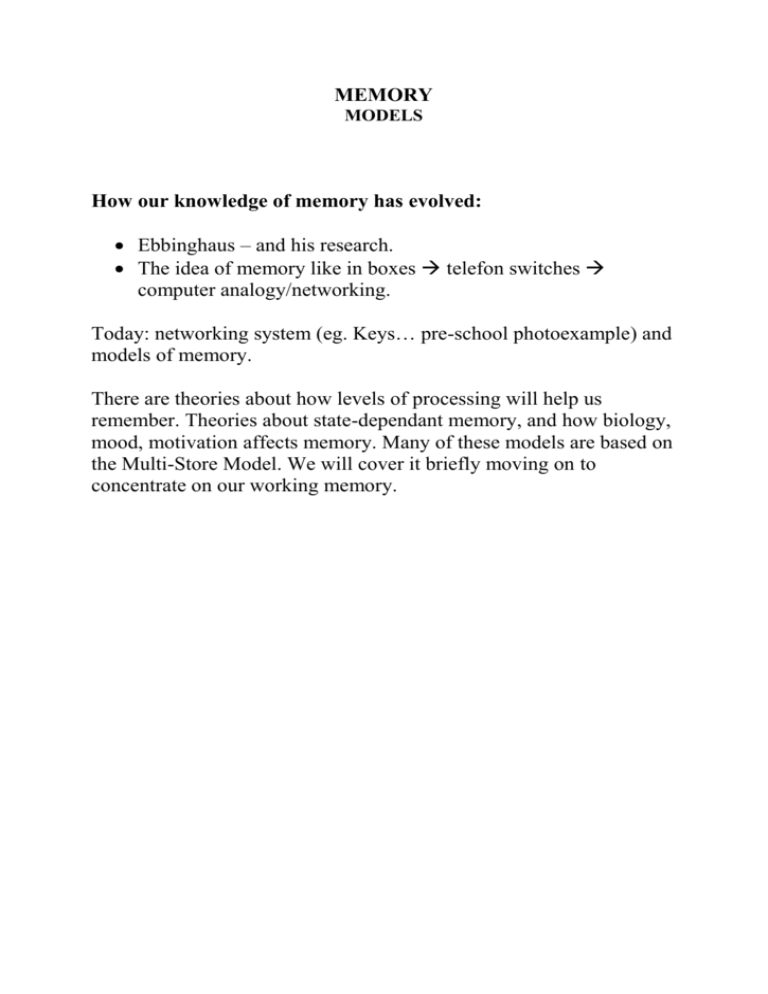
MEMORY MODELS How our knowledge of memory has evolved: Ebbinghaus – and his research. The idea of memory like in boxes telefon switches computer analogy/networking. Today: networking system (eg. Keys… pre-school photoexample) and models of memory. There are theories about how levels of processing will help us remember. Theories about state-dependant memory, and how biology, mood, motivation affects memory. Many of these models are based on the Multi-Store Model. We will cover it briefly moving on to concentrate on our working memory. ONE MEMORY MODEL: Class 1. 1. Give them mindmap – discuss briefly. Homework: make it your own – colour, change, add information and pictures etc. The Atkinson & Shiffrin ‘Multi Store Model’ (1968) A number of memory theorists have proposed that the memory system is divided into three stores, the Sensory Store, the Short Term Memory, and the Long Term Memory. Stimulus Input Sensory Store STM LTM limited capacity Unlimited capacity Lost/Displacement Page 73. This is typical of structural models of memory in that it: A flow of information through a system. Including different stages in fixed order. Capacity and duration limitations in each store. Worth to mention is also that this model is clearly inspired by computer science. The Sensory Store External stimuli from the environment first enter sensory memory, where they can be registered for a very brief period of time before decaying or being passed on to the short term store. Example: you ask “pardon”? And then realize what has just been said… Why – Baddeley 1988 suggested: it helps creating a flow instead of seeing or hearing short cuts of our reality. Connecting and intergrating our sensations creating what we see as our reality. For example if you move a light rapidly round in a circle you will also ‘see’ a circle because the trace of the lighter is left behind. If you move the light slowly only parts at time will be seen since it is too slow for the sensory memory to keep track of the traces. Same if you see a film, the film is really presented as a rapid series of frozen images interspersed by fleeting moments of darkness, but thanks to our sensory store our mind will hold one piece of information until the next is presented and be put together like a smooth movements. Short-term Memory If things entering our Sensory Store will be attended to it will move into STM Depending on rehearsing and attention. Example: In a discussion with your friend you come up with something you want to say but when it’s finally your turn to talk you forgot! What happened? You didn’t have a chance to rehearse. It works as a buffer and we can’t keep more information in it than we can attend to. Capacity: Miller (1956) tested the span of STM through: But how much can we keep in there…? 8 7 4 6 3 4 9 6 2 4 2 7 7 1 6 5 1 4 0 1 3 8 1 8 3 9 5 5 2 1 3 1 4 9 7 5 2 4 8 9 3 7 1 0 4 2 8 9 7 9 1 7 0 4 2 0 4 1 8 5 ‘magical number 7’. But actually a normal person can keep 7+-2 digits in STM. Let’s do it with letters: UVAFCICRBSAi VCRFBIUSACIA Or even CARHOUSEROOF What we are talking about here is something called ‘chunking’grouping into meaningful sequences or clusters. Some people (with nothing better to do apparently) have practiced this to excellence. One man could keep 80 digits in mind but he had practiced a lot. When tested on letters instead he didn’t do better than average, so it’s all about practicing. Long-term Memory Our vast and uncountable long term storage. The problem here is not availability but accessibility. Support: 1. Serial position effect. Glanzer and Cunitz (1966) used free recall of a list of 20 items combined with an interference task to show that there are two processes involved in retrieving information. They showed lists of 20 words one at a time and had subjects recall the words under one of three conditions. With 0 seconds delay the first 5 and last three words were recalled best but with a 10 or 30 second delay there was little effect on the early words but poor recall of later items. This has been called the serial position effect and suggests that the earlier words had been passed to long-term memory. Experiment showing the serial position effect: Book, window, loan, table, disk, car, bribe, stapler, bathtub, comb, wire, key, food, box, hat, ring 3 groups, one writes immediately, one writes after having counted in 7 and upward to 140, one writes after having counted backwards from 140. Results group 1: words from the beginning and the end of the list are better recalled than those in the middle of the list. Better recall of the words early in the list results from a primacy effect (more time to rehearse and better attention amongst other reasons), while better recall at the end of the list results from a recency effect (the words are still consciously present in STM). Poorest recall is of words in the middle of the list, as these are lost whilst rehearsal of the early items. Results group 2: a distractor task can substantially reduce recall of the words at the end of the list. Result group 3: even worse. 2. Studies of brain damaged people showing that some damages seem to lead to information not being able to transfer from STM to LTM – perhaps then showing that there are indeed two different systems. HM (Milner, 1966) had a surgery to the temporal lobes and the hippocampus in order to cure epilepsy, but was left with an unusual type of memory loss. He had a normal shortterm memory and could recall his distant past but he could not retain any new information. He appeared to lack the ability to transfer information from the STM to the LTM. Patiences with Korsakoff’s Syndrome (alcohol damage) have poor long-term memories but normal short-term memories. These differences are best explained by the theory that there are different memory stores. But this support is very unspecific. Today the multi-store models seems both out-dated and simplified (Eysenck, 1996). New findings showing that it is possible to remember sounds but not verbal materials like letters meaning that the STM that Atkinson/Shiffrin used needs developing and that LTM is devided into procedural, episodic and semantic memory. The original model isn’t discarded new findings have enhanced the original Multi-Store Model. Baddeley and Hitch’s Working Memory Model Hand out text – read and worked with until next class! Do experiments: Experiment on this: Experiment 1 Idea: recite something you know well, aloud, let someone time you. Do it again silently, let someone time you (should be approximately the same), now, take the first word/letter/number loud, the second silently, third loud, fourth silently etc. Shift of attention here takes time because we are talking about two different systems. Example: Blinka lilla stjärna. Experiment Interesting extras: People who do well on these tasks (with a ‘high capacity’ working memory’) tend to: Do well on intelligence tasks. Suppress unwanted thoughts. Are more likely than other people to prefer a large reward later instead of a small reward now Can often name many animals in 10 minutes and do not mix up different lists. But if they have to make, say a noise at the same time, like tapping a rhythm with fingers, all lose their attention but these do the worst. So what does this say about music while studying? Start class 2 with youtube clip: http://www.youtube.com/watch?v=4gg6Xd1teZ0&translated=1 Add “content questions on handout” here ! Systematic reading help to p. 73-76 – the basics What is the difference between short term memory (Atkinson & Shiffrin) and the working memory model (Baddeley and Hitch, 1974): The central executive is described as a controlling system that monitors and coordinates the other components. The most important job is attentional control. Name and describe the two ways this happens: 1. _____________________________________________________________________ 2. _____________________________________________________________________ The role of the episodic buffer is, according to Baddeley: The phonological loop is divided into two components. Briefly describe the two of them: The visuo-spatial sketchpad – see next page for further information. Experiments using Dual task techniques are named as the best piece of evidence there is for the Working Memory Model. Describe the idea and exemplify with BAddeley and Hitch’s experiment (1974): Evaluation of the Working memory model. Each paragraph in this section (p. 75-76) contains one evaluation point. Describe each: 1. 2. 3. READING GUIDE TO ”WORKING MEMORY” p. 1-3 By Robert H. Logie Introduction, p. 1 On the first page Logie claims that working memory can be thought of as the desktop of the brain. Explain how! Logie also suggests two reasons why it has been so successful 1. _____________________________________________________________________ 2. _____________________________________________________________________ Four methods are mentioned to have been used when developing this model. 1. ____________________________ 2. ____________________________________ 3. ____________________________ 4. ____________________________________ Basics of working memory, p. 1-2 Name and describe two basic features of the working memory mentioned on page 1. There is a paragraph highlighting the differences between the passive STM and the new concept of working memory. Retell! Visual appearance and location Baddeley and Hitch proposed the Visuo-spatial sketchpad as a part of the working memory model already 1974, 1986 and then finally revised 2001. Still, very often something called the Visual Cache is mentioned (for example in this text by Logie). Logie himself proposed the idea of a Visual Cache as one out of two systems of the Visuo-spatial sketchpad – and his section on visual appearance and location is mainly about this Visual Cache. The other part of the visuo-spatial sketchpad is the inner scribe. This is the division between the two: Visual cache – stores form and colour information. The inner scribe – deals with spatial and movement information and body movement; rehearses and transfers information in the visual cache to the central executive. Read the following text to understand the difference between the Visuo-spatial sketchpad and the visual cache (used in Logie’s text). Three main findings provide evidence for the distinction between visual and spatial parts of the visuospatial sketchpad: 1. There is less interference between visual and spatial tasks than between two visual tasks or two spatial tasks (Quinn & McConell, 1996) 2. Brain damage can influence one of the components without influencing the other. For example stroke patient data (Beschin et al. 1997) 3. Results from brain-imaging (PET) show that working memory tasks with visual objects activate mostly areas in the left hemisphere, whereas tasks with spatial information activate more areas in the right hemisphere eg. Smith and Jonides, 1997) The visuo spatial scetchpad is highly useful as it: Helps us remember the location of features in our direct surrounding but also allows us to generate new information. For example by drawing information from our knowledge base to imagine how something would look like, manipulating these features in our head. Come up with your own example of this!

